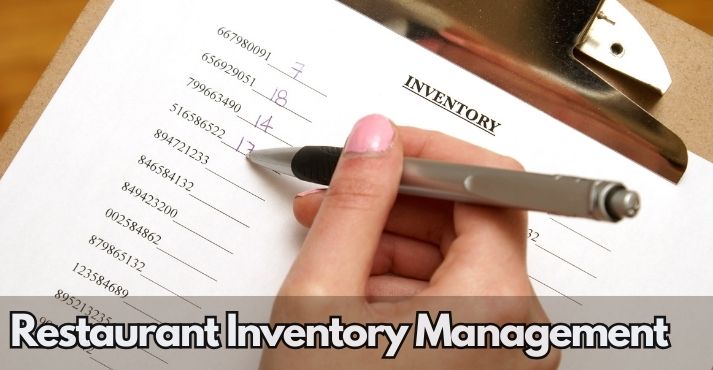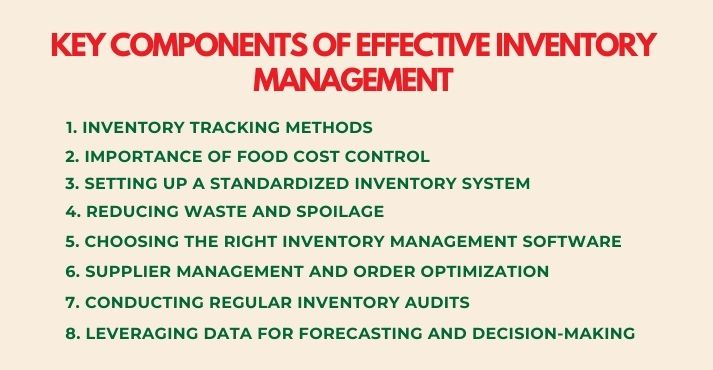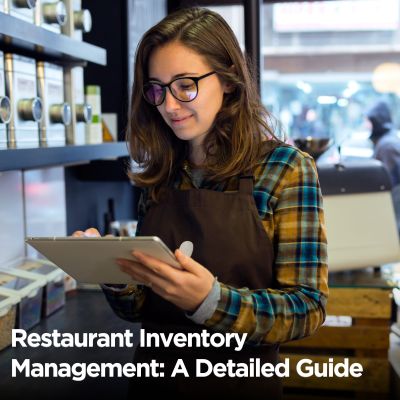Keeping a restaurant profitable is all about balancing quality service with smart cost management. One of the biggest challenges in the industry is maintaining an efficient inventory system.
Without proper tracking, food can spoil before it is used, main ingredients may run out unexpectedly, and costs can skyrocket.
Every wasted product or miscalculated order reduces profits, making restaurant inventory management an important part of running a successful business.
When inventory is not properly controlled, restaurants face unnecessary expenses, food waste, and operational disruptions. Ordering too much leads to spoilage, while ordering too little results in disappointed customers and missed sales.
Disorganized storage and inaccurate stock counts can make things even worse. To avoid these problems, restaurant owners need a structured approach to tracking stock, controlling costs, and optimizing purchases.
This guide will cover essential restaurant inventory management strategies, including best practices, tracking methods, and tools to keep operations running smoothly and profitably.
What is Restaurant Inventory Management?

Restaurant inventory management is the process of tracking food supplies, monitoring ingredient usage, and managing costs to ensure efficient operations. It helps prevent waste, manage expenses, and ensure that menu items are always available.
A good inventory system allows restaurants to order the right amount of ingredients, avoid running out of essential items, and keep the kitchen running smoothly.
Proper restaurant inventory control is important for both profits and customer satisfaction. When restaurants don’t manage their inventory well, they often spend more money than necessary, waste food, and struggle to serve their full menu.
Studies show that 4% to 10% of food purchased by restaurants is wasted before it even reaches customers. This not only increases costs but also harms the environment.
Restaurants handle inventory in different ways. Some still use manual methods like spreadsheets and regular stock counts, while others rely on inventory management software.
Modern digital solutions connect with point-of-sale (POS) systems to track stock automatically, provide real-time data, and predict future inventory needs.
Whether using traditional methods or advanced technology, keeping accurate inventory records helps restaurants reduce waste, lower costs, and improve efficiency.
Key Components of Effective Inventory Management

Managing restaurant inventory is more than just counting ingredients. It requires a structured system that helps track stock levels, control costs, and minimize waste.
A well-organized inventory process ensures that restaurants always have the right ingredients on hand without overstocking or running out of main items.
To achieve this, restaurants must implement effective inventory tracking for restaurants, implement food cost control strategies, and use standardized systems to streamline operations.
Proper restaurant supply management also helps reduce waste, improve ordering efficiency, and maintain profitability. Here are the main elements that make an inventory management system effective:
1. Inventory Tracking Methods
Tracking inventory accurately is crucial for preventing shortages, minimizing waste, and controlling costs. Poor inventory management can lead to significant financial losses, with businesses losing up to 11% of their annual revenue due to stockouts and overstocking.
Restaurants use various methods to monitor their stock, including:
- Manual Counts: Staff physically count inventory at regular intervals. While simple, this method can be time-consuming and prone to errors.
- Spreadsheets: Many restaurants use spreadsheets to record stock levels, track usage, and monitor trends over time. However, human error and outdated data can make this method unreliable.
- Inventory Management Software: Modern software solutions automate tracking and provide real-time updates on stock levels. These tools help restaurants optimize ordering, reduce errors, and improve efficiency.
Real-time tracking is important for ensuring that ingredients are available when needed while preventing overstocking.
Integrating inventory management software with restaurant supply management systems, such as point-of-sale (POS) integration, helps restaurants track inventory automatically, improving accuracy and reducing manual work.
A great example of effective inventory tracking is McDonald’s, which uses an advanced Just-in-Time (JIT) inventory management system to streamline operations and minimize waste.
By using real-time data and automated tracking, McDonald’s ensures that each location only stocks what it needs, reducing overstocking and food spoilage
2. Importance of Food Cost Control
Controlling food costs is important for maintaining profitability. Since ingredients account for a significant portion of restaurant expenses, even small inefficiencies can lead to major financial losses.
By tracking ingredient usage, restaurants can reduce waste, optimize purchasing, and prevent unnecessary spending. Some effective strategies for food cost control include:
- Portion Control: Standardizing portion sizes ensures consistency and minimizes excess usage.
- Menu Engineering: Analyzing menu profitability helps prioritize high-margin items and phase out less profitable ones.
- Supplier Negotiations: Building relationships with suppliers can lead to better pricing, discounts, and cost savings.
Implementing these strategies allows restaurants to maximize revenue while maintaining quality and reducing expenses.
3. Setting Up a Standardized Inventory System
A standardized inventory system helps restaurants track stock consistently, reduce waste, and improve efficiency. According to McKinsey, companies that standardize their inventory can cut holding costs by up to 20%, leading to significant savings.
Some essential components of a structured system include:
- FIFO (First In, First Out): Using older ingredients before newer ones prevents spoilage.
- Par Levels: Setting minimum stock levels helps avoid shortages and over-ordering.
- Batch Tracking: Monitoring inventory by batch ensures freshness and quality control.
Organizing inventory properly is just as important. Categorizing ingredients based on storage needs and tracking expiration dates prevents waste and improves kitchen operations.
Well-organized storage areas also make it easier for staff to locate ingredients quickly, improving overall efficiency.
4. Reducing Waste and Spoilage
Food waste is a major issue in the restaurant industry, leading to unnecessary costs and sustainability concerns. Reducing waste requires a combination of proper stock rotation, portion control, and creative food usage strategies.
- Stock Rotation: Following FIFO principles ensures that older ingredients are used first.
- Creative Use of Leftovers: Repurposing excess ingredients into new dishes can minimize waste.
- Monitoring Expiration Dates: Regularly checking inventory prevents spoilage and unnecessary disposal.
Tracking waste also helps identify inefficiencies in inventory tracking for restaurants. If certain ingredients are frequently discarded, it may indicate over-ordering or improper storage.
By analyzing waste trends, restaurants can adjust purchasing decisions and improve overall efficiency.
5. Choosing the Right Inventory Management Software
Managing inventory manually can be time-consuming and prone to human error. Traditional methods like spreadsheets and manual stock counts work for small restaurants, but inventory management software improves accuracy, automates tracking, and boosts efficiency.
These digital solutions help streamline stock tracking, minimize waste, and improve overall cost control.
The global inventory management software market was valued at USD 2.31 billion in 2024 and is expected to reach USD 2.51 billion in 2025, reflecting the growing demand for automated solutions in the restaurant industry.
When selecting the right software, restaurant owners should consider the following features:
- Automation – Reduces manual work by tracking stock levels, reordering supplies automatically, and updating inventory in real-time.
- POS Integration – Syncs inventory with sales data to ensure accurate ingredient usage and avoid discrepancies.
- Real-time Analytics – Provides insights into stock trends, waste reduction, and food cost control, helping businesses make data-driven decisions.
- Mobile Accessibility – Enables restaurant managers to track inventory remotely from any device.
Popular inventory management tools include MarketMan, BlueCart, and Upserve, which cater to different restaurant sizes and operational needs.
Additionally, industry events like the Food Service Equipment Trade Show showcase the latest advancements in restaurant technology, helping businesses find the best solutions for their inventory needs.
An example of this is Chipotle, which has integrated the RFID (Radio Frequency Identification) technology into its inventory management system to improve supply chain visibility and stock tracking.
The system allows the company to monitor ingredient usage, expiration dates, and supplier details in real time. By automating these processes, Chipotle reduces human error, minimizes food waste, and ensures that ingredients remain fresh.
6. Supplier Management and Order Optimization
Building strong relationships with suppliers is essential for cost efficiency, consistent quality, and smooth kitchen operations. Restaurants that manage their supplier networks effectively can secure better pricing, maintain product quality, and reduce the risk of stock shortages.
Here are a few strategies to optimize supplier management and ordering:
- Bulk Purchasing – Ordering ingredients in larger quantities often results in lower prices and reduces overall costs.
- Negotiating Better Rates – Establishing long-term contracts with suppliers can lead to discounts and priority access to high-quality ingredients.
- Quality Control – Regularly reviewing supplier performance ensures ingredient consistency and minimizes the risk of delays or subpar products.
- Order Scheduling – Using restaurant supply management tools helps regulate ordering schedules, preventing stockouts and excess inventory.
Restaurants can explore new supplier partnerships and industry trends by attending Horeca Trade Show events, where vendors showcase their latest products and services.
7. Conducting Regular Inventory Audits
Regular inventory audits help maintain stock accuracy, reduce losses, and identify inefficiencies in food inventory management for restaurants. Without proper auditing, discrepancies in stock levels can lead to financial losses and food waste.
There are several types of inventory audits that restaurants can implement:
- Daily Spot Checks – Quick counts of high-use ingredients (e.g., meat, dairy, and produce) to detect shortages and inconsistencies.
- Weekly Counts – More detailed assessments that help track stock trends and prevent discrepancies before they become major issues.
- Full Monthly Audits – Comprehensive reviews of all inventory items to ensure financial accuracy and cost control.
To improve audit efficiency, restaurants should assign dedicated staff for inventory checks, use inventory management software, and compare stock records with sales data to identify discrepancies.
8. Leveraging Data for Forecasting and Decision-Making
A data-driven approach to inventory management allows restaurants to predict demand, optimize ordering, and reduce food waste. Using real-time data to track inventory improves stock accuracy by 35%, reducing errors and discrepancies in inventory counts.
By analyzing historical sales data and inventory trends, restaurants can make informed decisions that enhance efficiency and cost savings. Some ways restaurants can use data for better inventory management include:
- Identifying Seasonal Trends – Understanding which menu items sell best during specific times of the year can help restaurants adjust stock levels accordingly.
- Improving Ordering Patterns – Data analysis helps restaurants anticipate demand, preventing both overstocking and shortages.
- Using Predictive Analytics – AI-powered forecasting tools can predict inventory needs based on past trends, helping businesses optimize food costs and reduce waste.
By integrating data analytics into their restaurant stock management strategies, businesses can enhance profitability while ensuring they always have the right ingredients on hand.
A well-managed inventory system reduces operational inefficiencies and improves overall restaurant performance.
Common Challenges in Restaurant Inventory Management

Managing restaurant inventory efficiently is no easy task. From tracking stock levels to preventing waste, restaurant owners and managers face several hurdles that can impact profitability.
Without a solid inventory management system, businesses may struggle with cost control, food waste, and operational inefficiencies.
Addressing these challenges with the right solutions allows restaurants to streamline inventory processes and enhance overall performance.
1. Inaccurate Stock Counting
Human errors in manual tracking are one of the most common causes of inventory discrepancies. Staff may miscount stock, forget to log usage, or enter incorrect data into spreadsheets, leading to unreliable records.
Despite the availability of digital tools, 43% of small businesses still use manual tracking systems or don’t track inventory at all, increasing the risk of stock mismanagement and financial losses.
Strategies to improve accuracy:
- Double-check stock counts by having two employees verify numbers.
- Implement inventory tracking software to automate stock updates.
- Schedule routine stock checks to catch errors before they cause major issues.
2. Overordering and Underordering
Striking the right balance between having enough stock and avoiding excess waste is a challenge. Overordering leads to spoilage, wasted food, and unnecessary expenses while underordering results in stockouts that disrupt service and disappoint customers.
Solutions to optimize ordering:
- Use historical sales data to determine demand patterns and adjust order quantities.
- Set par levels (minimum stock thresholds) to ensure essential ingredients are always available.
- Automate reordering through restaurant supply management software to maintain stock efficiency.
3. Theft and Shrinkage
Inventory shrinkage due to employee theft, supplier discrepancies, or administrative errors can significantly impact profitability. Whether intentional or accidental, missing stock affects food cost control and makes it difficult to track actual inventory levels.
Ways to prevent theft and shrinkage:
- Restrict inventory access to authorized personnel only.
- Use security cameras in storage areas to deter theft.
- Keep detailed purchase and usage records to track discrepancies.
- Regularly audit supplier deliveries to ensure accuracy.
4. Lack of Real-Time Monitoring
Without real-time inventory tracking, restaurants may struggle to manage stock levels efficiently. Relying on outdated systems, such as manual spreadsheets, makes it difficult to track ingredient usage and predict shortages before they occur.
Solutions for real-time tracking:
- Implement cloud-based inventory software that updates stock levels instantly.
- Integrate inventory management with POS systems to track ingredient usage automatically.
- Use mobile inventory apps for on-the-go stock monitoring and reorder alerts.
By addressing these common inventory challenges with technology, better tracking methods, and proactive management, restaurants can improve cost efficiency, reduce waste, and ensure smooth operations.
Conclusion
Effective restaurant inventory system is essential for running a profitable and well-organized business.
By tracking stock levels accurately, controlling food costs, and reducing waste, restaurants can improve efficiency, minimize losses, and enhance customer satisfaction. Poor inventory control leads to unnecessary expenses, operational disruptions, and missed revenue opportunities.
Using technology and best practices, such as real-time tracking, standardized inventory systems, and supplier management, can streamline operations and prevent common pitfalls like overordering, theft, and spoilage.
Cloud-based inventory management software, POS integrations, and data-driven forecasting tools help restaurants make smarter purchasing decisions and optimize stock levels.
By implementing proactive inventory strategies, restaurant owners can boost profitability, cut costs, and maintain smooth operations.
Investing in the right tools and refining inventory processes will not only ensure a well-stocked kitchen but also create a more sustainable and financially sound business.











